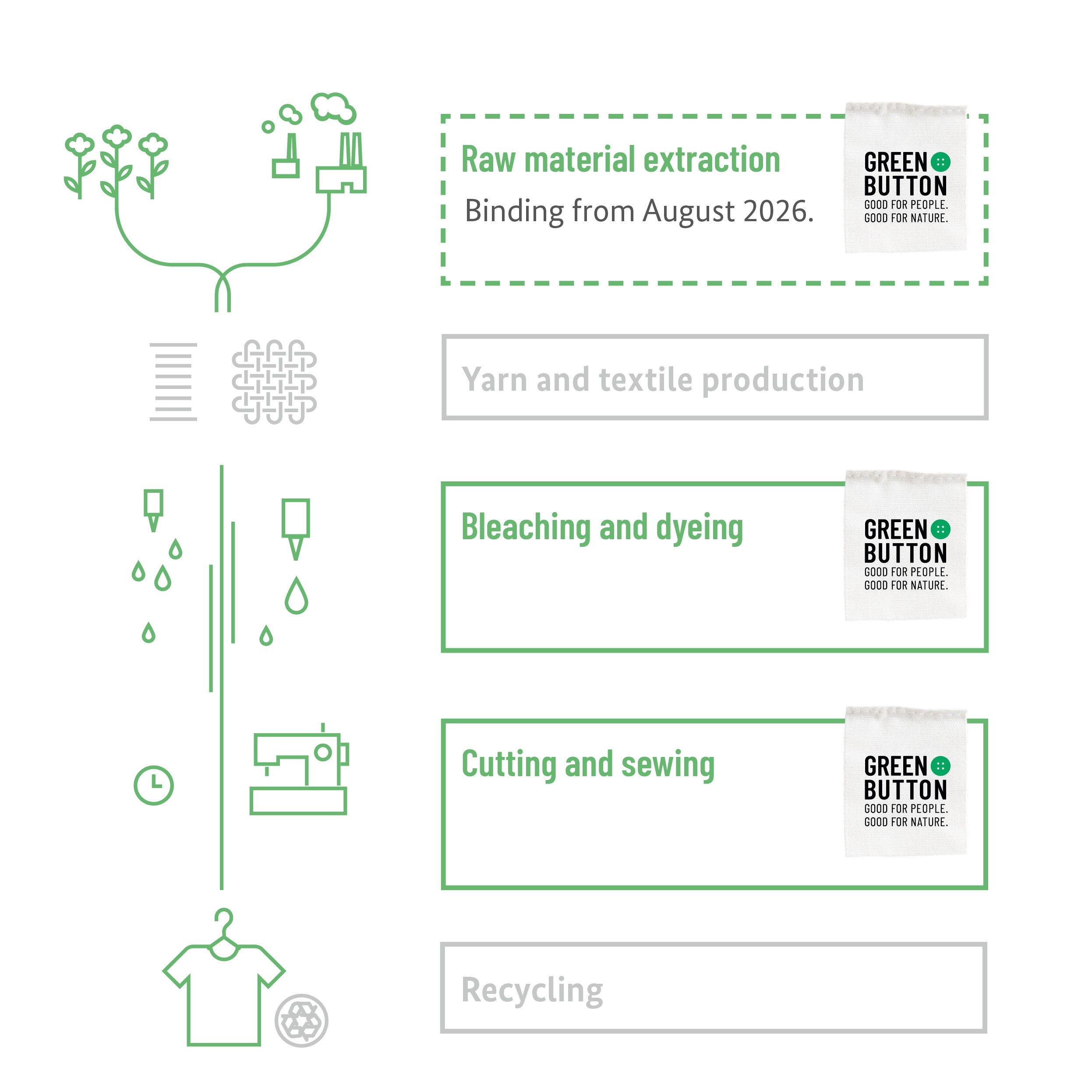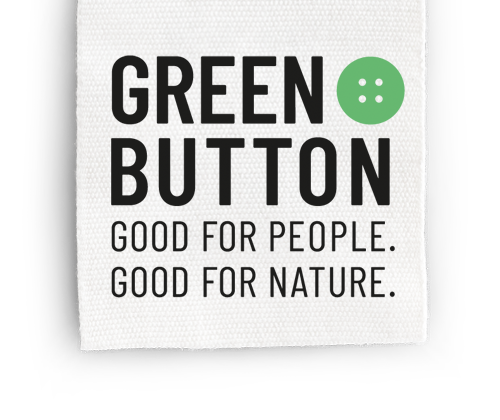Requirements for production processes
Verified by credible certification labels
Requirements for production processes
Green Button 1.0 and Green Button 2.0
The Green Button is only awarded to products that come from responsible companies and have been produced with sustainability aspects in mind. At the start of the Green Button, these were particularly environmental requirements for bleaching and dyeing as well as requirements for social and working conditions during cutting and sewing. In addition to the expansion of the existing criteria, the Green Button 2.0 now also includes requirements for the sustainable extraction of raw materials. Products may only contain approved fibres and materials.
As proof of sustainable production, the Green Button accepts certification labels that meet the credibility criteria of the German federal government and have evaluated the required social and environmental requirements in the supply chain. Companies must provide proof of corresponding certification labels for these supply chain stages.

Recognised certification labels for the Green Button
Here you can find the list of approved fibres and materials as well as the list of all certification labels recognised by the Green Button. Addionally, you can find a guidance to the list of approved fibres and materials.
Raw material extraction and fibre and material use
In raw material extraction, one encounters both major social and environmental challenges - for example, in the cotton field, where pesticides are often used, and child labour is still widespread. There are also challenges with other natural fibres, with fibres of animal origin and around man-made fibres through unsustainable forestry, for example. The latest version of the standard, Green Button 2.0, therefore includes raw material extraction.
Examples
Prohibition of genetically modified cotton
Prohibition of genetically modified cotton
- No genetically modified seeds may be used in cotton production.
- Cotton must also come from sustainable agriculture.
Fibres from sustainable forestry
Fibres from sustainable forestry
- Plant-based synthetics such as viscose may only come from sustainable forestry.
- If they do not come from forestry, they come from controlled organic cultivation or controlled organic animal husbandry or are by-products or residual or waste materials.
Animal welfare requirements
Animal welfare requirements
- Animal fibres must come from species-appropriate husbandry (organic standard/ensuring the "5 Freedoms")
- Prohibition of mulesing in sheep's wool in case of a proportion of > 30%.
- Prohibition of live plucking and force-feeding for down and feathers in case of a proportion of > 30%.
Limit values for pollutants
Limit values for pollutants
- There are requirements for the reduction of synthetic pesticides and specifications for the use of chemicals.
- Virgin polyester may only be used in exceptional cases and then must not exceed defined limit values for the heavy metal antimony.
Promotion of recycled fibres
Promotion of recycled fibres
- Fibres and materials are generally permissible if they are recycled or recyclable in principle.
- Virgin synthetic fibres may only be used in exceptional cases, e.g. if 70% of the end product consists of recycled material.
Bleaching and dyeing
Hazardous chemicals are sometimes used in the bleaching, dyeing, and impregnating of textiles. Inadequate handling of wastewater can severely pollute drinking water. In order to be able to label a product with the Green Button, binding ecological requirements therefore apply to this production step. The existing requirements for the Green Button 1.0 have been expanded, sharpened, and new ones added as part of the 2.0 version of the standard.
Examples
Prohibition of hazardous chemicals
Prohibition of hazardous chemicals
- Hazardous chemicals and substances of concern are prohibited.
- There are limits for certain chemical residues.
- Protective equipment and training are mandatory when handling chemicals.
Limit values for wastewater
Limit values for wastewater
- The wastewater is analysed and disposed of in accordance with the law, e.g. in sewage treatment plants.
- There are limits, e.g. for the pH-value, the temperature, the chemical oxygen demand, and the total organic carbon.
Less air pollution and CO2
Less air pollution and CO2
- Air emissions are monitored and reduced - this applies in particular to the greenhouse gases CO2, dust, nitrogen, and ozone-depleting substances.
Keeping an eye on water and energy consumption
Keeping an eye on water and energy consumption
- Water and energy consumption are monitored.
Less waste
Less waste
- Waste generation is reduced.
- Waste flows and disposal are monitored.
Cutting and sewing
Piecework in stuffy factories, 16-hour shifts, lack of protective clothing, dismissal in case of pregnancy, and lack of safety measures are not uncommon in textile factories. That is why there are mandatory label-related requirements for decent work in cutting and sewing. The existing requirements of the Green Button 1.0 have been further developed for this production step and are more sophisticated in the Green Button 2.0. New requirements have also been added.
Examples
Prohibition of child labour
Prohibition of child labour
- The worst forms of child labour are prohibited.
- There must be an age verification system in place.
- Minimum age limits are observed.
- Special rules apply to young workers.
- There must be a defined procedure for dealing with child labour if it does occur.
Working hours and paid overtime
Working hours and paid overtime
- The standard working time is limited to a maximum of 48 hours per week.
- There is at least one day of rest per week.
- Overtime is voluntary and paid.
- Working hours are documented and there are regular break times.
- Sub-contracted workers have equal rights.
Right to freedom of association and collective bargaining
Right to freedom of association and collective bargaining
- Workers have the right to represent their interests and to form or join organisations to do so.
- Representatives of these organisations are granted access to all workplaces.
- Working conditions may be negotiated.
Ensuring occupational safety and health
Ensuring occupational safety and health
- An occupational safety and health system is in place.
- Personal protective equipment is provided.
- The company provides first aid personnel and basic medical care in case of occupational accidents.
- Building safety and fire protection requirements.
Prohibition of forced labour
Prohibition of forced labour
- Forced labour and debt bondage are prohibited.
- Workers can move freely.
- Neither papers nor wages are withheld.

